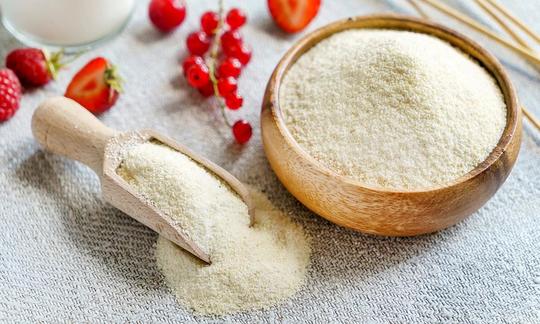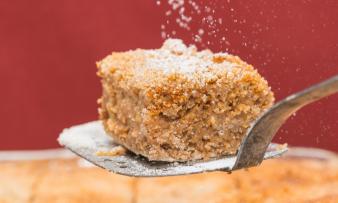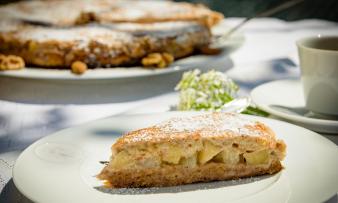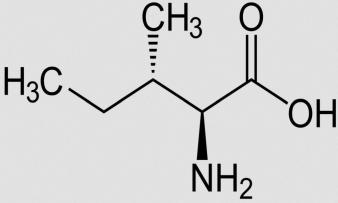Table of contents
Unenriched soft wheat semolina is a raw processed product ( organic?) made from the grain of the same name, soft wheat (Triticum aestivum). Soft wheat is also known as bread wheat, seed wheat, common wheat or summer wheat. Only semolina with a uniform grain size and less than one percent flour content can be called soft wheat semolina.
Using soft wheat semolina in the kitchen:
Soft wheat semolina cooks very easily and has a creamy consistency - in contrast to durum wheat semolina, which tends to stay solid when cooked due to its higher gluten content. Soft wheat semolina is therefore often used instead of durum wheat semolina for desserts such as semolina porridge and semolina flammerie (semolina flammerie or semolina heads), for cakes or roasts. Semolina made from soft wheat is also used in baby food, soups and puddings. Semolina dumplings and semolina balls with soft wheat semolina are a well-known soup ingredient in both Germany and Austria, or they make a fine dessert when sweetened with cinnamon, sugar or compote.
Soft wheat semolina is a good binding agent because the crushed grains allow the gluten contained in the soft wheat semolina to develop very well and bind liquid after a short boil. Soft wheat semolina can also be used to thicken and bind dishes such as soups or sauces 1 or added when baking bread.
Recipe for vegan soft wheat semolina porridge (semolina flammerie):
Ingredients (for 2 servings): 40 g soft wheat semolina (organic), 300 ml almond milk (or oat milk), 1 tbsp sugar, ¼ vanilla pod.
Preparation: Put the almond milk (oat milk) with the sugar and vanilla pulp in a saucepan and bring to the boil. Add the semolina and mix everything with a whisk. Now reduce the heat and let the mixture simmer for about 5 minutes (stir well). Pour the vegan semolina porridge into molds rinsed with cold water and chill in the refrigerator for at least two hours. Before serving, turn the semolina flammerie out of the molds. The dessert can be complemented with a delicious vanilla or fruit sauce and fresh fruit ( strawberries,raspberries orblueberries).
Recipe for vegan chocolate cake with soft wheat semolina:
Ingredients: 200 g soft wheat semolina (organic), 200 g cane sugar, 500 ml plant-based milk ( soy milk, oat milk, almond milk), 250 g ground almonds, 1 packet of baking powder, 30 g cocoa powder, 20 g cornstarch, 1 pinch of salt.
Preparation: Preheat the oven to 175 °C top and bottom heat. Now mix the dry ingredients in a bowl, add the plant milk and stir the dough well. Pour the dough into a greased and floured loaf pan. The cake should bake in the oven at 175 °C for approx. 40-50 minutes. To make sure that the cake is really baked through, poke it with a thin skewer. If no dough sticks to the skewer, the cake can be taken out of the oven. Now just let it cool and then cut into pieces to serve.
For more recipes using soft wheat semolina, see the link: " Recipes that make the most of this ingredient ".
| Not only vegans or vegetarians should read this: Vegans often eat unhealthily. Avoidable nutritional mistakes. |
Shopping - where to buy soft wheat semolina?
Supermarkets and wholesalers such as Coop, Migros, Denner, Volg, Spar, Aldi, Lidl, Rewe, Edeka, Hofer etc. have semolina made from soft wheat in their range. Organic soft wheat semolina can also be found there occasionally, but in any case in health food stores, organic shops, in organic supermarkets such as Denns's Biomarkt and Alnatura, in drugstores or specialty stores. You can also buy soft wheat semolina (not enriched, raw, organic) on various websites and in online shops.
Storage:
Always store non-enriched soft wheat semolina in a cool, dry place and away from odorous ingredients such as coffee, tea and spices, as it is susceptible to absorbing foreign odors. Semolina tends to form lumps due to moisture. 2
In conventional semolina production, the shell and germ are separated before grinding, which means that the soft wheat semolina can be kept for several years. When shopping, pay attention to the expiration date of the semolina product you have bought. However, such dates always refer to the "minimum shelf life" and are no indication of spoilage after the expiration date if stored correctly. A closer look and a smell test can help to judge the shelf life.
Store fresh foods made from soft wheat semolina, such as semolina porridge, in the refrigerator and use them within 1-2 days.
Ingredients - Nutritional values - Calories:
The 360 kilocalories in 100 g of non-enriched soft wheat semolina (raw, organic) come mainly from carbohydrates. At 73 g/100g, 27% of the daily carbohydrate requirement is covered. With 10 g of protein, soft wheat semolina has a slightly higher protein content than corn (9.4 g/100g) and whole grain rice (7.2 g/100g). However, chia seeds (19.5 g/100g) and amaranth (14.2 g/100g) have a significantly higher protein content. Fat is present at 1.5%. 3
By consuming 100 g of soft wheat semolina, you can cover 36% of your daily folate (folic acid) requirement. The proportion of 72 µg/100g is comparable to wheat bran and broccoli. Kidney beans (394 µg/100g) and lentils (479 µg/100g) have a particularly high folate (folic acid) content. 3 Folic acid is important for cell renewal and cell growth. Pregnant women or women who are trying to become pregnant in particular should ensure they have an adequate supply (550 µg daily 4), as the vitamin plays a crucial role in the development of the fetus. 5 When consuming folate, it should be remembered that it is one of the heat-sensitive vitamins and suffers significant losses even when heated slightly. After preparation, the actual proportion of folate (folic acid) is therefore lower than when raw.
100 g of semolina contains 0.49 g of phenylalanine and thus covers 32% of the daily requirement. Basmati rice and buckwheat have similar values. Hemp seeds (1.4 g) and soybeans (2.1 g) have a significantly higher content. 3 Phenylalanine contributes to the synthesis of important proteins in the body, such as the neurotransmitters adrenaline, dopamine and serotonin or the skin pigment melanin and the hormone "thyrox.." (T 4). Phenylalanine can strengthen memory performance and curb appetite. 6,7
The amount of manganese in soft wheat semolina is 0.62 mg/100g. This covers 31% of the daily requirement. Breadcrumbs and cooked quinoa contain comparable amounts. Chickpeas (2 mg/100g) and wheat germ (13.3 mg/100g) have very high manganese contents. 3 The human body needs manganese for its carbohydrate metabolism, its urinary cycle and for the formation of cartilage tissue, among other things. 8
The complete ingredients of soft wheat semolina, the coverage of the daily requirement and comparison values with other ingredients can be found in our nutrient tables. In the article Nutrients explained you will get a detailed insight into the topic.
Health aspects - effects:
Is soft wheat semolina healthy? According to studies, non-enriched soft wheat semolina has a comparatively low glycemic index. You can also find "whole grain semolina" (semolina with some husk), which has a GI of 50. "Normal" semolina has a glycemic index of 65. Both values are in the middle range of the GI scheme, which lies between 50 and 70, which is why the term "low" is not entirely correct here. 10
Semolina is therefore suitable for diabetics in moderate amounts because it causes blood sugar levels to rise more slowly than, for example, parboiled and long-grain white rice. 9 Semolina made from soft wheat has a low fat content and is very filling due to its high protein and fiber content. Fiber also helps to lower blood fat levels, excrete cholesterol and promote digestion.
Dangers - Intolerances - Side effects:
People with celiac disease and gluten sensitivity should avoid soft wheat semolina because it contains a lot of gluten. What is the difference between durum wheat semolina and soft wheat semolina? Soft wheat contains a slightly lower protein content and has a slightly different composition than durum wheat semolina, which is even richer in gluten. 17
What is celiac disease? Celiac disease is defined as a food intolerance that triggers an autoimmune reaction in genetically predisposed patients 11. The affected person suffers from an intolerance to the grain protein gluten, which is contained in many types of grain. The introduction of a gluten-free diet as a treatment method has significantly reduced the mortality rate, which was previously at 60%. Celiac disease can occur in both childhood and adulthood. 20% of patients first diagnosed are over 60 years old. People with celiac disease must avoid consuming any products containing gluten. What many people do not know is that gluten is hidden as an additive in many foods. Even medications can contain gluten. Therefore, always check the ingredients of a product before buying it to make sure that it really does not contain gluten. The symbol with the crossed-out ear of corn is a helpful indicator here. Gluten-free options include rice, wild rice, corn, millet, buckwheat, amaranth and quinoa. 11
In addition to gluten intolerance, there is also wheat allergy or wheat sensitivity. Here, too, those affected must avoid consuming wheat products, such as soft wheat semolina. 12 The consumption of wheat triggers an immune reaction in which the body tries to fight the protein contained in the wheat by forming antibodies. Typical symptoms are abdominal pain, flatulence, diarrhea, nausea, tiredness and skin reactions such as itching and rashes. Although wheat allergies occur in all age groups, they are very rare. 13
Folk medicine - natural healing:
Soft wheat semolina is very easy to digest due to its small grains and is therefore often used as a light diet for gastrointestinal diseases. However, fine soft wheat semolina is significantly less nutritious than semolina, which still contains husks and germs.
Occurrence - Origin:
It is assumed that people first cultivated wheat around 8,000-10,000 years ago, in its original wild form. It is considered the second oldest form of grain after barley and has its origins in Ethiopia. Today it is cultivated worldwide in temperate and subtropical climates. The most important growing countries include China, India, the USA, France and Russia. 2
The cultivation of common wheat ( Triticum aestivum) accounts for 90% of the world harvest. It can be grown as both a summer and winter cereal.
Semolina production:
Is soft wheat semolina white flour? The production of soft wheat semolina is similar to conventional flour production, with the difference that soft wheat semolina is coarser than flour.
How is semolina made? In conventional semolina production, the coarsest impurities and damaged grains must first be removed. For the next step, special scrubbing machines are used to remove the last stubborn dirt. Before the grains are ground, they are peeled to remove the germ and the shell. In several passes, large steel rollers grind the grains into semolina. The resulting flour must be sieved after each pass. To obtain fine grains, the rollers are set a little tighter after each pass. 14
By subsequently adding the germ and the shells, you get a much more nutritious semolina. Since most of the nutrients are contained in the shell and the germ, the so-called enriched semolina contains significantly more minerals, vitamins and fiber than conventional semolina. 15 The differences lie primarily in the B vitamins (including folate) and the iron content. 3 But depending on the product, other substances can also be enriched.
However, semolina can never be described as a whole grain product, as the flour part is always separated during semolina production and it therefore never contains all the components of a grain. 16 additional milling steps result in semolina flour from soft wheat semolina.
General information:
Which grain is semolina made from? Soft wheat semolina is made from soft wheat. This type of wheat is one of the most economically important plant species. The soft, floury grains are easy to grind, which means that less starch is destroyed during the milling process. There is also durum wheat semolina made from durum wheat ( Triticum durum) and spelt semolina ( spelt semolina ), which is made from spelt ( Triticum aestivum ssp. spelta), as well as other variants (see ingredient semolina).
Alternative names:
In English, soft wheat semolina is also known as soft wheat semolina, farina or bread wheat farina, although farina is not a clearly defined term and does not primarily refer to soft wheat semolina. 18 Soft semolina appears to be a short form for soft wheat semolina.
Alternative spellings include soft wheat semolina (and incorrectly also soft wheat grits). Outside Switzerland, in German-speaking countries, the spelling soft wheat semolina (or simply semolina) is common, for example in search combinations such as: recipe semolina dumplings soft wheat semolina.
Literature - Sources:
Bibliography - 18 Sources (Link to the evidence)
| 1. | Essen-und-trinken.de Griess: kleine Warenkunde. |
| 2. | Blumenthal Dr. A, Stransky Dr. M. Ernährung und Lebensmittel von A bis Z. Herausgeber: Editions M, 1. Auflage 1993. |
| 3. | USDA United States Department of Agriculture. |
| 4. | DGE Deutsche Gesellschaft für Ernährung. |
| 5. | Greenberg J, Bell S, Guan Y et al. Folic Acid Supplementation and Pregnancy: More than just neural tube defect prevention. 2011 Summer;4(2): 52–59. |
| 6. | Kasper H, Burghardt W. Ernährungsmedizin und Diätetik. 11. Auflage. Elsevier GmbH, Urban & Fischer Verlag: München. 2009. |
| 7. | Biesalski HK, Grimm P. Taschenatlas der Ernährung. 6. Auflage. Georg Thieme Verlag: Stuttgart und New York. 2015. |
| 8. | Brodziak-Dopierała B, Kwapuliński J et al. The content of manganese and iron in hip joint tissue. J Trace Elem Med Biol. Juli 2013;27(3):208–12. |
| 9. | Ridner E, Di Sibio A. Glycemic index of two varieties of pasta and two varieties of rice. Arch Latinoam Nutr. 2015 Jun;65(2):79-85. |
| 10. | Diabetes-austria.com Glykämischer Index (pdf). |
| 11. | Smollich M, Vogelreuter A. Nahrungsmittelunverträglichkeiten Lactose-Fructose-Histamin-Gluten. Verlag: Wissenschaftliche Verlagsgesellschaft: Stuttgart. 2. Auflage 2018. |
| 12. | Ricci G, Andreozzi L, Cipriani F et al. Wheat Allergy in Children: A comprehensive update. Medicina (Kaunas). 2019 Jul; 55(7): 400. |
| 13. | Lebensmittelunvertraeglichkeiten.de Weizenallergie. |
| 14. | Gesundheit.de Griessherstellung. |
| 15. | nutritionintl.org Wesley A, Ranum P (edd.). Fortification Handbook. Vitamin and mineral fortification of wheat flour an maize meal. The Micronutrient Initiative. 2004. |
| 16. | Spielberger-muehle.de Getreidewissen: Griess. |
| 17. | Žilić S, Barać M et al. Characterization of proteins from grain of different bread and durum wheat genotypes. Int J Mol Sci. 14. September 2011;12(9):5878–94. |
| 18. | El-Bouziri M. Farina milling: development of a flow sheet and a speck counting method. Thesis. Department of Grain Science and Industry. Kansas State University. 1988. |










Comments